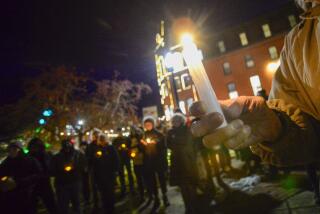Unsolved killing is the talk of Iraqis’ English class
El CAJON, Calif. —This day’s English lessons for Iraqi immigrants at Cuyamaca College involved learning how to talk about bad news.
From their text, “Day by Day: English for Employment Communication,” the 25 students repeated dialogue wrapped around common occurrences: “I lost my wallet” and “My husband got fired from his job.”
But the students had a horrific piece of real news on their minds: the March 24 death of an Iraqi immigrant who had been bludgeoned with a tire iron in her home three days earlier. A note near her bloodied body called her a terrorist and told her to “go back to your country.”
“They can’t stop talking about it,” said the instructor, Hayfa Dalali, an immigrant from Baghdad. “They just keep saying: ‘She was a mother of five, from a nice family, in a safe neighborhood.’”
Predictably, the unsolved killing of 32-year-old Shaima Alawadi has led to heightened concern among some women about their safety.
But in this working-class suburb east of San Diego, the nation’s second-most-populous community of Iraqi immigrants, the fear does not seem to spring from a belief that the killing was a hate crime committed by a predator stalking Iraqis.
While hardly crime-free, El Cajon has no history of hate crimes or of overt hostility toward immigrants from Iraq or other Middle Eastern countries, according to crime statistics. There is no graffiti or gang activity linked to anti-immigrant animosity, police and Iraqi community leaders say.
Students in the class at Cuyamaca College appear to be taking their lead from the El Cajon police, who have said that the specter of a hate crime is only one possible motive and that detectives are exploring evidence besides the threatening note that the victim’s 17-year-old daughter, Fatima, said she discovered by her mother.
The killing is “an isolated incident,” police have said repeatedly.
Officials of the San Diego branch of the Council on American-Islamic Relations and the Los Angeles-based Muslim Public Affairs Council have urged residents not to jump to conclusions and to wait for the police to find the killer. So did Imam Sharif Battikhi at a memorial service for Alawadi at the mosque in nearby Lakeside.
Sahar Hussein, 50, an Iraqi immigrant by way of Egypt, said she knew Alawadi from the mosque in El Cajon, where she was always smiling and helpful.
“She was such a nice lady, always friendly to others,” Hussein said during a break in the language class. “I’m scared now and being careful until we know the reason. We trust the police.”
With a population of 100,000, El Cajon is a spread-out city divided by Interstate 8. Wide avenues are chockablock with strip malls. Iraqi markets and restaurants are clustered downtown, near courts, government offices and the police headquarters.
“We will let the police handle this thing,” said Othman Kalasho, 58, who came to the U.S. in 1978 and owns Ali Baba Family Restaurant on East Main Street. “One criminal should not be applied to everybody. Just think how much this country has helped refugees from Iraq.”
Speculation within the Iraqi community about the motive has been continuous and wide-ranging.
“Who knows?” Nash Isho, 38, said as he played dominoes at the Baghdad Cafe amid large-screen televisions showing Iraqi music videos and an Arab soap opera. “Most people are friendly here to us, but maybe it’s a personal thing, maybe a family thing. Who knows?”
On his way to the Babylon Market, 29-year-old Ray Tobiya admitted being perplexed: “It could be so many things. Maybe things nobody wants to talk about.”
Cuyamaca College, one of two campuses of the Grossmont-Cuyamaca Community College District, is a major gathering spot for Iraqi immigrants. Located on the city’s outskirts, the campus has tall trees, a large grassy commons and light-colored buildings, not altogether different from college campuses in the modern Arab world.
As the influx of Iraqi immigrants increased in the last decade, the college district has taken a leadership role. It held a summit on meeting the needs of the new immigrants, and last school year more than 5,300 students enrolled in English language classes at the district’s two campuses. More than 80% were Iraqi immigrants.
A demographer at San Diego State estimates that nearly 30,000 people of Iraqi origin live in San Diego County. Some statistics suggest that El Cajon is surpassing the Detroit suburbs as the top destination for Iraqi immigrants; Shaima Alawadi, her husband, and their five children had lived in Dearborn, Mich., before moving.
In the wake of Alawadi killing and the unrelated drive-by shooting of a teenager, Cuyamaca College President Mark Zacovic last week sent an email to students, faculty and staff saying: “We are disturbed by the nature of these criminal acts and abhor the pall that these, and every act of violence, cast over our East County community.… We value free thinking and freedom of speech, and we deplore actions that make any member of our community feel less than fully welcomed.”
In Dalali’s class, students want to learn English to help get jobs. Some worked for the U.S. military in Iraqi. Unemployment for Iraqi immigrants exceeds the overall jobless figures for the region, officials said.
Although the killing has saddened Mumina Al Naqishbandi, 47, a Kurdish Iraqi who moved to El Cajon a year ago with her husband and five children, it has not shaken her belief that El Cajon is safe.
“People say hello to me; it’s normal,” she said. “This is a safe community, not like places in Iraq. I am so sorry for the lady and her family.”
Al Naqishbandi’s 18-year-old son, Mohammed, is studying English so he can pass the test to enlist in the U.S. Army.
“He said, ‘This is my country now, I should help defend it, so my family will be safe,’” she said.
More to Read
Start your day right
Sign up for Essential California for news, features and recommendations from the L.A. Times and beyond in your inbox six days a week.
You may occasionally receive promotional content from the Los Angeles Times.





